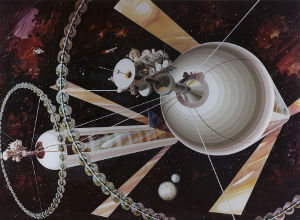
O'Neill Cylinders, illustration by Rick Guidice for NASA

A = ω2 * rIf you are moving within that rotating station, you will experience an additional apparent force:
where ω is the station rotational velocity, and r is the radius.
F = 2*m* (ω x v)This basically means that if you are climbing up a ladder, you will feel as if you are pulled in the anti-spinward direction, and the reverse if you are climbing down a ladder, just as balls behave if you throw them up or down in the simulator above. You can read a much more detailed discussion of this in this paper by Theodore Hall.
where:
m is your mass,
ω is the station's rotational velocity vector (the axis of rotation with length equal to rotational speed),
v is your velocity vector in the rotating frame,
x is cross product, thus making the resulting "force" perpendicular to both ω and v.